Let's dance! Regional dancers share expertise and merge talent in Seychelles biennale
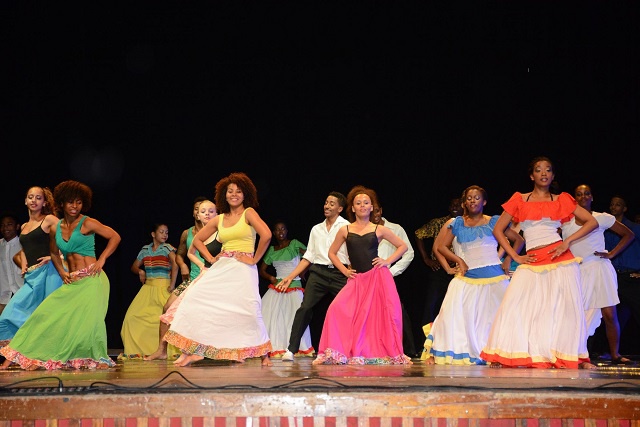
Dancers from Seychelles, Reunion, Madagascar and Rodrigues performed together in a two-hour show at the end of two weeks of sharing dance experiences and learning new techniques. (Patrick Joubert, Seychelles News Agency)
(Seychelles News Agency) - Hip-twisting, turning, swaying, stepping and stunts all performed to the beat of classical and modern ballet, jazz, hip-hop, traditional and contemporary dance added to a mixture of colours, sounds and elongated movements to tell a particular story.
That was what a show lasting well over two hours on Saturday, at the International Conference Centre, in the Seychelles capital of Victoria, was offering to the public.
Staged by some 25 amateur and professional dance enthusiasts, the performance was the culmination of two weeks of sharing experiences and learning from one another in the 8th Seychelles Biennale de Dance [Seychelles Dance Biennale].
The biennale is organised by the School of Dance, which falls under the National Conservatoire of Performing Arts.
‘Caution’, which saw a group of young men and women dressed as construction workers move to the beat of peeping horns, drilling sounds culminating with a sharp dramatic piano instrumental was one of three choreographed dance pieces presented by the Seychelles side.
The Seychellois dancers also presented a rhythmic ‘Sega’ and the traditional “kanmtole” [traditional dances of European origin] - merged with steps from the traditional music of Rodrigues, which forms part of the territory of the neighbouring Indian Ocean island of Mauritius.
 |
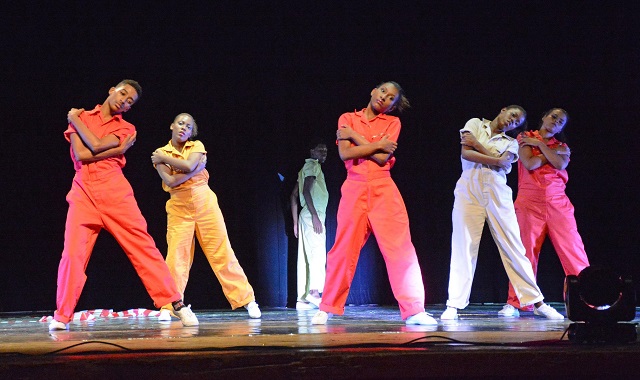 |
| The Seychellois dance crew who took part in the 2015 Biennale. (Patrick Joubert, Seychelles News Agency) Photo License: CC-BY |
The Tahala dance company from Madagascar chose to perform a mixture of ballet, jazz and hip-hop while Rodrigues also came up with a traditional medley featuring several of the island’s very rhythmic traditional dances.
“For our group it is the first time we learn classical dance. In Madagascar, we mostly learn hip-hop and other modern dances…This has been beneficial because it allowed us to learn more techniques,” a representative of the Madagascar dance crew told SNA.
For its part, Reunion, a French overseas department in the Indian Ocean presented a ballet dance that was very physical, with a lot of graceful, elongated movements.
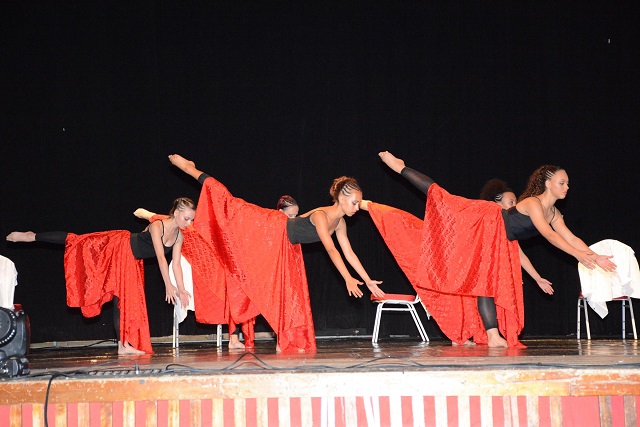 |
| Reunion's Regional Federation of Dance with their ballet performance. (Patrick Joubert, Seychelles News Agency) Photo License: CC-BY |
Although it was not a packed audience, those who made it to the show were quite impressed with the performance.
“The show was very interesting and beautiful as usual. I love dancing so for me, I loved all the performances. I am a loyal supporter of the Biennale; I have attended all the shows since it started,” a lady in her 40’s told SNA.
Interestingly, nationals of the participating regional islands currently residing in Seychelles had also come to support the dancers from their homeland.
“The show made people who do not even know how to dance want to dance. I have seen that contemporary dancing has moved to a higher level. I am from a Malagasy dance group in the Seychelles and by watching the show I have learnt some new techniques.”
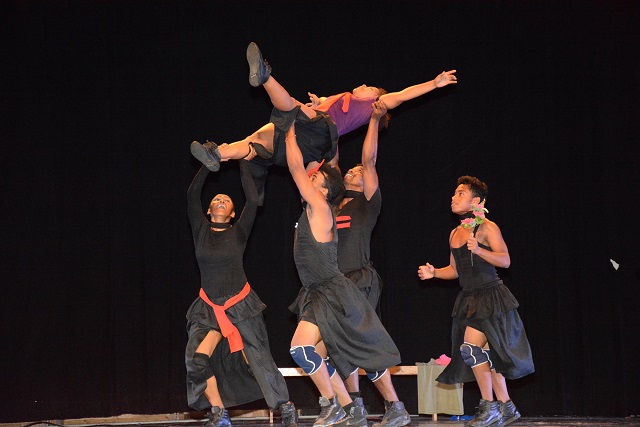 |
| Madagascar's performance saw a mixture of ballet, jazz and hip-hop. (Patrick Joubert, Seychelles News Agency) Photo License: CC-BY |
The show itself culminated with a piece choreographed by British choreographer Charlotte Pook, which saw a combination of what the dancers had learnt over the past two weeks.
“It was an amazing experience…They [the dancers] were very open, committed and passionate thus making it easy to take on what I had to say and bring in their style to the work,” said Pook at the end of the show.
The professional choreographer is of the view that each island had brought in different elements that complimented each other.
“Seychelles has a lot of clarity in its work, they have a lot of discipline and they are very aware of themselves in terms of space. Madagascar brings a lot of different types of energy and passion. Reunion Island is very technical and they are very good at elongating movements. Rodrigues Island has a lot of enjoyment in their dance. So to have all four islands to participate made it really great for me to work with different groups.”
Pook, who applied to come to Seychelles as the international guest choreographer for this year’s biennale, said that she had been focused on what she could bring to the dancers at the same time what she could get out of them.
“There are great talents. Something I have learnt with the Seychelles is that the people are willing to be here and they don’t just want to be paid for it. They are literally here to enjoy the pleasures of dancing. They enhance themselves so when it comes to the performance they up it to another level. There are definitely a few people who can go professional.”
Pook holds a Bachelor’s degree in dance theatre and a Master’s in dance performance with the Trinity Laban Conservatoire of Music and Dance, in Greenwich, London.
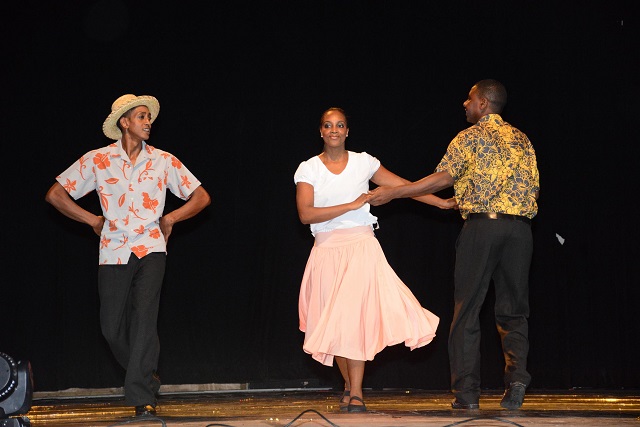 |
| Rodrigues was more about traditional dances. (Patrick Joubert, Seychelles News Agency) Photo License: CC-BY |
First observed in 1997, the Seychelles Dance Biennale, as the name suggests takes place every two years in the Indian Ocean archipelago providing a platform for cultural exchanges among local, regional and even international dance enthusiasts allowing them to be exposed to a variety of dance forms and techniques.
“It is also aimed at attracting more people in the society to appreciate dance and get new dance enthusiasts to enroll,” Ruth Barbe, a choreographer working at the Seychelles school of dance and member of the organizing committee, told SNA in an interview.
For all dancers, the two weeks participating in the dance biennale has been an enriching experience.
“At home we learn traditional dances of Rodrigues, we learn the modern Sega, traditional dances and hip hop. Contemporary dance was a bit difficult at first but we are getting used to it now. We are also learning a bit the traditional dances of Seychelles, which is very similar to our own dance, very rhythmic. This was not so difficult for us to learn,” said Francine Lalanne from Rodrigues.
Seychellois dancer and instructor, Denis Rose was appreciative of the fact that although very young, the group of dancers were very skillful.
“These sessions are ideal for me because I want to specialize in contemporary dance. In the past, I had the chance to explore Madagascar’s contemporary dance and bit of Reunion’s classic contemporary. So I am gaining most from the visiting choreographer. The style is interesting; it is very new to me, a blend of classic and abstract contemporary. It quite a challenge but I prefer to appreciate the experience.”
Charlotte Payet from Reunion Island described the workshop as an opportunity for enrichment and to learn how dance can broaden one's horizons.
“This year, Reunion Island had organized a biennale but it was not the same as the one in Seychelles. It is mostly a show to bring together all the schools of dance. Nevertheless, we have the same aim; that is, to learn from each other’s unique dance style.”
According to Charlotte, there is not much opportunity for a dancer to progress to become a professional in Reunion compared to what she has seen in Seychelles where there are dancers who have studied at university level.
Seychellois choreographer Ruth Barbe, for example, has a Bachelor’s degree in dance from the Western Academy of Performing Arts, Edith Cowan University and Joel Rose studied at Trinity Laban Conservatoire of Music and Dance, at Greenwich, London.
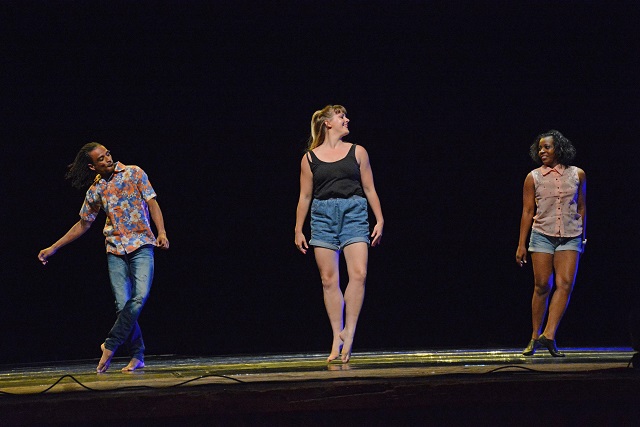 |
| British choreographer Charlotte Pook (centre) performing alongside Seychellois choreographers Ruth Barbe (right) and Joel Rose (left). (Patrick Joubert, Seychelles News Agency) Photo License: CC-BY |
Since it started in 1997 only one biennale was not organized and the year that follows each biennale is also used to provide local dancers with a similar experience in a foreign country.
Apart from Mauritius, Madagascar and Reunion, the Seychelles Dance Biennale has over the last eighteen years seen the participation of dancers from China and Singapore and guest choreographers from South Africa, France, Singapore and Madagascar.
SNA presents a collection of photos taken at the Seychelles Dance Biennale show on Saturday. (Patrick Joubert, Seychelles News Agency) Photo License: CC-BY
 |
 |
 |
 |
 |





